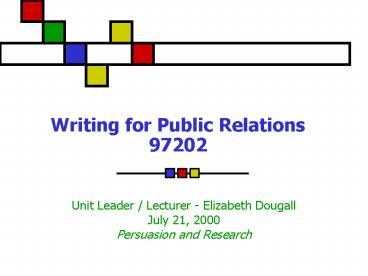Writing for Public Relations 97202 - PowerPoint PPT Presentation
1 / 18
Title:
Writing for Public Relations 97202
Description:
Persuasion and Research. Your Audiences Are Volunteers ... Persuasion ... Persuasion. Revisit Maslow's hierarchy of needs (see text Chapter 3) ... – PowerPoint PPT presentation
Number of Views:20
Avg rating:3.0/5.0
Title: Writing for Public Relations 97202
1
Writing for Public Relations97202
- Unit Leader / Lecturer - Elizabeth Dougall
- July 21, 2000
- Persuasion and Research
2
Your Audiences Are Volunteers Learning
Objectives - after completing the workload for
this week you will be able to
- identify the difference between writing
strategies and tactics - define and differentiate controlled and
uncontrolled media, publicity and advertising
- describe some of the guidelines for and pitfalls
of persuasive communication - outline steps for research and preparation.
3
Strategies and Tactics
- There are two fundamental elements of any writing
project in public relations - Strategy - determines what and when to
communicate and to whom - Tactics - encompasses the choice of channels etc
to facilitate the strategy
4
Differentiating Media / Tools
- Controlled Media
- Uncontrolled Media
- Publicity and Advertising
5
Advertising
- is time or space which is purchased directly
and carries the buyers message. The content and
delivery of the message is controlled by the
buyer. - Are community service announcements advertising
or publicity?
6
Publicity
- is information supplied to the public without
charge - The organisation does not control the final
content or delivery of the message UNLESS they
own the medium. - Information supplied as publicity can appear in
any form or not at all - at the discretion of the
medium.
7
Persuasion
- To persuade effectively is a great challenge -
level of difficulty depends on the beliefs,
attitudes and opinions of your target publics. - Persuasive messages may be pitched as rational
and / or emotional appeals.
8
Persuasion
- Revisit Maslows hierarchy of needs (see text
Chapter 3)
- The communication-design aspects of persuasion
include - 1. Stimulus-Response
- 2. Cognitive
- 3. Motivational
- 4. Social
- 5. Personality
9
Persuasion
- Six steps of persuasion (McGuire)
- 1. Presenting
- 2. Attending
- 3. Comprehending
- 4. Yielding
- 5. Retaining
- 6. Acting
- Relate this to a decision-making / persuasion
experience of your own
- .
10
PersuasionSome gems and old chestnuts in the
persuasion conundrum
- In controversial situations
- If your audience is sophisticated, present both
sides of the issue
- Inoculate if you anticipate your opposition
will raise an issue - Present your opponents views first, and then
your own
11
Persuasion
- In General -
- Tell the good new first
- Spell out your conclusions clearly - dont leave
the audience guessing - Mild fear appeals work better than strong ones
- Offer solutions (not just problems)
- If you want to achieve major attitudinal change -
aim for a little at a time - incremental
erosion. - See your text for more
12
Research in Public RelationsMajor research
categories in PR
- Policy
- Background Material
- Audience
- Message
- Media
- Program Evaluation
13
Research in Public Relations
- Research in PR must...
- 1. Answer questions essential to planning
projects, programs and campaigns e.g.. how to
your target publics get and use information.
- 2. Test, if possible, deflate assumptions -
conventional wisdom, common sense etc - 3. Provide baseline data for evaluation -
benchmarks are essential - See Chapter 4 for more.
14
Research in Public Relations
- For some specific research guidelines, including
storage, retrieval, sources, interviewing etc,
refer to PP 72 to 84 of the text.
15
Next Week
- Adjustment to study schedule - next week we will
consider the principles of effective writing
before moving on to writing for the media.
16
Readings for this week
- Text - Chapter 2
- Selected Readings 3.1 - 3.3
17
Preparation for tutorials
- Contact an organisation you know, collect the
facts associated with something new and
interesting going on. You will be required to
describe and discuss those facts. - DO NOT COME TO CLASS WITHOUT THIS INFORMATION!
- Ensure that you bring keep your work from the
first tutorial as you will be required to build
on the exercise started in week one.
18
Contact Details
- Lecturer Elizabeth Dougall
- Tutors Elizabeth Dougall Alison Feldman
- Location Q211
- Phone 4631 1055
- Consutation Times
- Monday 12 - 2 pm Friday 12 - 1 pm.
- Ancillary materials are located at
- http//www.usq.edu.au/ancil/foa/97202/
- or via P drive accessed on-campus (Computer Lab)































